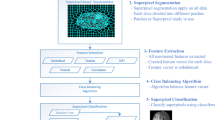Abstract
Brain tumour segmentation is a challenging task to perform from the brain MRI image. This is because the different parts of the brain have complex structures. The main objective of image segmentation is to segment the image into parts so that it’s easier to identify the tumour using the classification algorithm. In this paper, a simple linear iterative clustering (SLIC) segmentation algorithm is presented for the segmentation of brain MRI images. This algorithm categorizes the image into different superpixels, which are formed based on the pixel positions and spatial intensity value. However, the superpixels are combined with the neighbouring superpixels and form large regions for merging similar regions. In fast superpixel fusion, the pixel values in each superpixel are replaced by the average pixel value. Find the unique pixel values in the superpixels and cluster them based on the average pixel value. This results in superpixels being grouped into the background with average pixel value zero, grey matter with average pixel values less than two hundred and more than zero, and tumour and skull with average pixel values higher than two hundred. This operation fuses the superpixels at a faster rate and produces the fused superpixels for tumour classification.
Access this chapter
Tax calculation will be finalised at checkout
Purchases are for personal use only
Similar content being viewed by others
References
Kotte S, Pullakura RK, Injeti SK (2018) Optimal multilevel thresholding selection for brain MRI image segmentation based on adaptive wind driven optimization. Measurement 130(2018):340–361
Wadhwa, A, Bhardwaj A, Verma VS (2019) A review on brain tumor segmentation of MRI images. Magn Res Imaging 61: 247–259
Kumar D, Verma H, Mehra A, Agrawal RK (2019) A modified intuitionistic fuzzy c-means clustering approach to segment human brain MRI image. Multimedia Tools and Appl 78(10):12663–12687
Nguyen GiaNhu, Tiwari P (2019) Brain MRI image classification for cancer detection using deep wavelet autoencoder-based deep neural network. IEEE Access 7:46278–46287
Moeskops P, Veta M, Lafarge MW, Eppenhof KAJ, Pluim JPW (2017) Adversarial training and dilated convolutions for brain MRI segmentation. In: Deep learning in medical image analysis and multimodal learning for clinical decision support. Springer, Cham, pp 56–64
Dalca AV, Yu E, Golland P, Fischl B, Sabuncu MR, Iglesias JE (2019) Unsupervised deep learning for Bayesian brain MRI segmentation. In: International conference on medical image computing and computer-assisted intervention. Springer, Cham, pp 356–365
Devkota B, Alsadoon A, Prasad PWC, Singh AK, Elchouemi A (2018) Image segmentation for early stage brain tumor detection using mathematical morphological reconstruction. Proced Comput Sci 125: 115–123
Daimary D, Bora MB, Amitab K, Kandar D (2020) Brain tumor segmentation from MRI images using hybrid convolutional neural networks. Proced Comput Sci 167:2419–2428
Ranjbarzadeh R, Kasgari AB, Ghoushchi SJ, Anari S, Naseri M (2021) Brain tumor segmentation based on deep learning and an attention mechanism using MRI multi-modalities brain images. Sci Rep Article number: 10930
Ren T, Wang H, Feng H, Xu C, Liu G, Ding P (2019) Study on the improved fuzzy clustering algorithm and its application in brain image segmentation. Appl Soft Comput 81 (2019):105503
Hrosik RC, Tuba E, Dolicanin E, Jovanovic R, Tuba M (2019) Brain image segmentation based on firefly algorithm combined with k-means clustering. Stud Inform Control 28(2):167–176
Setyawan R, Almahfud MA, Sari CA, Rachmawanto EH (2018) MRI image segmentation using morphological enhancement and noise removal based on fuzzy C-means. In: 2018 5th international conference on information technology, computer, and electrical engineering (ICITACEE). IEEE, pp 99–104
Huang, H, Meng F, Zhou S, Jiang F, Manogaran G (2019) Brain image segmentation based on FCM clustering algorithm and rough set. IEEE Access 7:12386–12396
Wong-Kisiel LC, Quiroga DF, Kenney-Jung DL, Witte RJ, Santana-Almansa A, Worrell GA, Britton J, Brinkmann BH (2018) Morphometric analysis on T1-weighted MRI complements visual MRI review in focal cortical dysplasia. Epilepsy Res 140:184–191
Vijay J, Subhashini J (2013) An efficient brain tumor detection methodology using K- means clustering algorithm. In: 2013 International conference on communication and signal processing. IEEE, pp 653–657
Singh B, Aggarwal P (2017) Detection of brain tumor using modified mean-shift based fuzzy c-mean segmentation from MRI Images. In: 2017 8th IEEE annual information technology, electronics and mobile communication conference (IEMCON). IEEE, pp 536–545
Author information
Authors and Affiliations
Corresponding author
Editor information
Editors and Affiliations
Rights and permissions
Copyright information
© 2023 The Author(s), under exclusive license to Springer Nature Singapore Pte Ltd.
About this paper
Cite this paper
Snehalatha, Patil, S.R. (2023). An Improved Brain Tumour Detection and Classification Using SLIC Superpixel Fusion, Deep Learning and Linear Neighbourhood Semantic Segmentation. In: Kumar, S., Hiranwal, S., Purohit, S., Prasad, M. (eds) Proceedings of International Conference on Communication and Computational Technologies. ICCCT 2023. Algorithms for Intelligent Systems. Springer, Singapore. https://doi.org/10.1007/978-981-99-3485-0_67
Download citation
DOI: https://doi.org/10.1007/978-981-99-3485-0_67
Published:
Publisher Name: Springer, Singapore
Print ISBN: 978-981-99-3484-3
Online ISBN: 978-981-99-3485-0
eBook Packages: Intelligent Technologies and RoboticsIntelligent Technologies and Robotics (R0)




